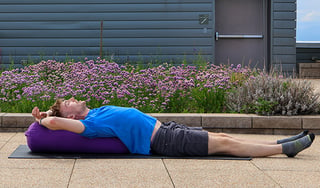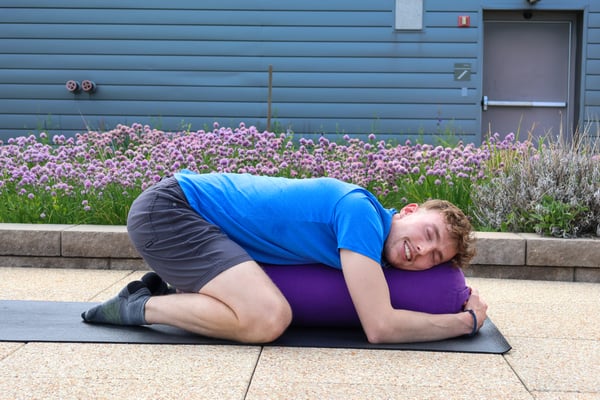-
Mobility and flexibility
The benefits that immediately come to mind are mobility and flexibility. Those are two things that everybody knows are really critical for performance. Whether you're a big marathoner, you like to hike over the summer, or if you sit at your desk for many hours a day, these activities are all demanding on your body. Getting into the practice of really mobilizing your body is going to help you feel better and perform better with whatever you do outside of yoga.
-
Balance
Balance is really important and is a little bit harder to train because your balance isn't like a muscle, and you can't attack it in the same way, but it becomes really critical, especially as we get older. Yoga helps with balance more than any other group fitness format. Balance work is functional and connects your brain to your body. It literally rewires your neuro pathways.
-
Mindfulness
We have a lot of new research about how mindfulness is a tremendously effective tool for boosting your mental health. And I think the phrase that has been thrown around since I started doing yoga back in the day that is still perfect is: Yoga is a moving meditation. The special way yoga combines movement with mindfulness makes mindfulness “click” for a lot of people.
-
A body connection
Yoga connects you to your body in a way that, in my personal experience, has been really healing in terms of my relationship with my own body. There is something that emerges over time – a self-knowing, a self-compassion. When you really quiet yourself and feel your body as it moves, you start to build a sense of deep personal trust in your body and in yourself. Over time you learn to feel a stretch as it blooms, and then you notice how it feels a little easier with your next breath or your next yoga practice.
And for me, that has been really special and beautiful and given me a lot of peace with my body. There was a time where I struggled with my body image. A lot of people do. Yoga really shifted that for me. You and your body is the closest relationship, the longest relationship, that you'll ever have in your life. It’s important to take the time to really be present in your body and feel what it's like to be alive. It’s an amazingly beautiful feeling.
-
Sense of community
Another mental health benefit, in a studio setting, is the community aspect.
I come from a group fitness background, so this is a phenomenon I see in all of our studios and classes. There is a feeling of belonging, which can get buried with all of the other great benefits of yoga, but it's one that I think is really important, especially coming out of the pandemic. I really saw how much people missed that piece of it – being in community with each other. Getting to know your instructor and the other friendly faces in the room makes yoga class feel less like an item on your to-do list, and more like spending time with friends. Before you know it, you have a consistent yoga practice and you’re feeling the benefits — physical, metal and social.
-
An array of styles
I trained in a more vigorous physical style of yoga, a vinyasa power-flow style. Vinyasa means linking breath to movement. But as I've been doing it, and as I'm getting older and creakier, I have really developed a love for the more restorative styles of yoga, the ones that feel supportive. Right now, I'm teaching a vinyasa flow class and also a slow-flow class where we get to really do some juicy stretching, some restorative poses and some good meditation.
-
Many online resources
I love being in-person in the studio setting, but I don't think there's a wrong place to start. In my personal journey with yoga, I started in the privacy of my own home on YouTube. There are so many resources online and certainly even more so after the pandemic. I was watching videos on YouTube, and it was a way for me to learn some of the foundational things. It then helped my confidence going into the studio because it can feel intimidating if you're walking into a class you've never done before. And it's also a reason that we are live-streaming our yoga classes here at the Anschutz Health and Wellness Center.

Trevor Cassidy demonstrates supported fish pose.
|
-
Beginners are welcome
My favorite beginner poses are all the ones that you can do on the ground, and we're taking a more restorative angle here: happy baby pose and child's pose each for 5 breaths. And if you've got a pillow or a yoga bolster in your house, before bed, my absolute favorite is a supported fish pose where you're reclining face up on the bolster into a supported child's pose where you turn face down hugging the bolster in. That little two-pose series is just everything.

Trevor Cassidy demonstrates supported child's pose.
|
-
Rounds out exercise regimen
I think the official recommendation is at least 60 minutes a week of some kind of flexibility or mobility routine. This is something I'm really familiar with from teaching lots of different styles of fitness where I'm doing a lot of the class. I know from my own experience that having yoga in the mix really protects my body and keeps me moving. For me, it’s a critical element of cross-training.
Too much of one thing is going to be too much. If all you're doing is running, or all you're doing is working at your desk for eight hours a day without moving around much, if all you're doing is a really strict weightlifting program, you have to get some kind of stretching, mobility and recovery in there. Otherwise, over time, you may run into injury.
It’s important to have a mix of everything: strength training, flexibility, mobility and something that gets your heart rate going a little bit as well. For me, yoga is the best mobility routine because its benefits go beyond cross-training. You don’t have to take my word for it. There are a couple thousand years worth of yoga practitioners who I’m sure would agree!
.png)





